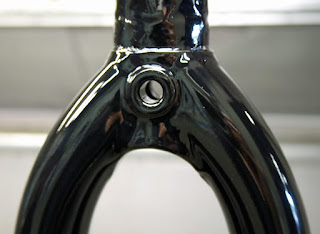Bike theft is a perennial problem and unfortunately, very lucrative
given there is a ready market for stolen goods. Thieves lack mercy and
compassion.
You and I have a bond with those frame tubes, a connection to those
components and little, personal touches-freedom, fun, friendship.
The thief sees cash, another order met, others a fleeting hit of heroin
to mute the spiralling misery of addiction and their steadily collapsing veins.
Those years spent living and riding in London’s seamier districts
cultivated a belt n’ braces pragmatism. Given theft is in epidemic territory,
I’m constantly staggered by the numbers of sitting ducks-easy pickings for the
light fingered. Take this fixed gear Trek spotted in central Coventry.
Yes its parked in very public locale’ but only secured by the top tube
using a modestly priced armoured chain…This might look the part but easily
defeated in a matter of seconds with bolt cropper, which the owner has
thoughtfully left ample space for…
How about this no-name fixer and rather fetching flat bar Charge spotted
outside Birmingham’s symphony hall... Again; tethered to an immovable object
via a U lock, in a very public spot by their top tubes…Roomy enough for a brute
force attack, wheels and other components are vulnerable to anyone of a
dishonest mindset, equipped with a run-of-the mill multi-tool/set of Allen
keys.
These could then be broken for spares, sold on online auction sites, or
built into a bike using a stolen frame, making its heritage much harder for
rightful owners to spot (in the unlikely event they were recovered). Rule of
thumb says buying the best locks you can afford- 10% of the bikes rrp is a good
yardstick.
Some can defeat on looks alone but generally speaking, all decent locks
buy us is time; time for a thief to be discovered or get frustrated and move
on. Most work on the basis of sixty seconds. Longer and they’ll look elsewhere.
The most professional will use vans and have various tools for defeating
armoured cable, chain and shackle designs.
However, many simply use one system-combining a U lock and armoured
cable/chain of similar quality can be enough to make a thief move on. Make it
as awkward for them as possible. Fill the lock; keep the mechanism clean,
lightly oiled and difficult for them to access. If it’s a pain for you, it’s
all the more difficult for them and ultimately; the better your chances of
remaining the rightful owner.
Expect a decent lock to weigh around the kilo mark- fine for carrying over
the shoulder for a few miles but on longer commutes, these become decidedly
uncomfortable, so best sitting in a pannier, or riding on their own frame or
rack mounted bracket.
Sold secure are the benchmark most insurers go by and have three
standards- Bronze, Silver and Gold. This denotes the time and sophistication
required to defeat them. Bronze is ok for low crime areas but can be
obliterated in sixty seconds using very primitive tools.
Often regular commuters will leave their locks chained to bike stands
and other street furniture-don’t. This makes thieves lives easier still, they
note the lock, come back with the right tools-a row of bikes... gone.
Organised criminals often drive around in vans looking for and
ultimately stealing bicycles/motorcycles. Takes six big men to lift a
relatively small Harley Davidson but once inside, alarms and other security are
instantly muted. Studies have also shown that even when crimes are being
committed, members of the public tend to turn a blind eye...
Inspect potential hosts for weakness. Rusty railings are easier to cut
through and gaffer/similar tape can hide evidence of cutting/tampering. Oh and
make sure structures, such as parking meters can’t be unbolted, bikes lifted
atop...Trees and other wooden structures should only be considered when your
bladder is screaming defcon1.
Defeated by locks, the light fingered also take a shine to expensive
components-stems, forks, derailleurs, saddlers etc. Arguably a commuter/daily
driver shouldn’t be so exotic but hub dynamos and similar equipment is ultra
practical. Replacement Allen bolts (Not the cheap as chips quick cam type) with
unique keys are a wise investment, making “locusting” unlikely.
Public service announcement served. Along with the Univega’s 2x9
transmission update, I’ve upgraded the front stopper in favour of these Avid
shorty 4 cantilevers and compression less cables.
Setting up the Avids proved remarkably straightforward and this
configuration offers improved modulation and feel with Microshift brifters
compared with the TRP predecessors. Timely too; since I’m due to take delivery
of a free parable design T2 trailer to compliment their Gorilla and Monkii cages.
The
latter has enabled resurrection of this Ibera stainless steel thermos bottle; consigned
to my cupboard when it’s sprung cage bracket expired and replacement proved
unavailable. Kindly Supplied by www.cyclemiles.co.uk to be reviewed in www.sevendaycyclist.com








































